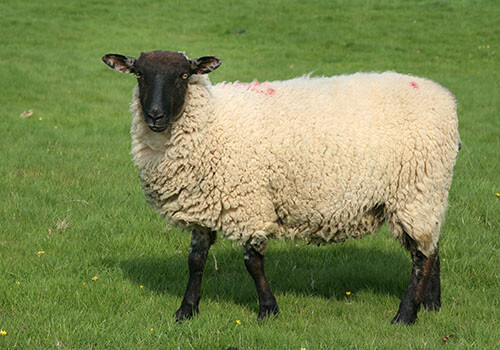Matching Sheep Feeds to Stage of Production 2020
Oct 19, 2020

Co-op proudly manufactures livestock feeds based on nutrient requirements, recent scientific research, and the latest knowledge of feed ingredients. Safety, nutrient interactions, and responsible use of feed ingredients were all considerations as we developed our line of sheep and lamb feeds appropriate for all stages of production.
Prior to breeding season, ewes may benefit from nutritional “flushing.” This term refers to providing supplemental energy to get ewes into a gaining plane of nutrition, indicating ample nutrients are available, allowing ewes to come into estrus and breed. A high-energy, low-starch feed is appropriate for this stage (#93303 Co-op 13% Pelleted All-Purpose Sheep Feed).
Once pregnant, a moderate energy ration should be used to prevent ewes from becoming over-conditioned (#355 Co-op 12% Pelleted Ewe Developer & Gestation Feed-CTC) and may help reduce udder edema and subsequent mastitis after lambing. The medication additive can reduce the incidence of vibrionic abortions. Avoid overfeeding, but make sure ewes consume adequate energy around lambing time to help guard against ketosis or “twin lamb disease.”
Once lambs are born, the ewe can gradually be transitioned to a lactation feed (#93553 Co-op 14% Pelleted Ewe Lactation Feed), higher in protein and energy to support the demands of milk production. Since lambs may consume some of the ewes’ lactation ration, choose a feed that contains ammonium chloride, a feed additive that helps to acidify urine in an attempt to ward off the occurrence of urinary calculi in male lambs. Providing a creep feed (#353 Co-op Pelleted Lamb Starter-BOV) to young lambs will better allow them to express their genetic potential for growth and development.
Growing lambs increase their feed intake while rapidly accumulating both muscle and skeletal tissue. Protein and energy concentrations in the feed need to be adjusted accordingly. At this stage, we recommend (#358 Co-op 16% Pelleted Lamb Grower/Finisher-BOV). Avoid over conditioning ewe lambs being developed as replacements, as fatty tissue can be deposited in the mammary tissue, negatively affecting future milk production.
To fatten or finish lambs for show or slaughter, feeds that provide high energy and moderate protein are appropriate (#93531 Co-op Show Lamb Feed-BOV). In this phase, accretion of muscle and skeletal tissue slows drastically, while accumulation of fat cover increases. The ionophore Bovatec® is approved for use in growing and finishing lamb diets to help them be more feed efficient, gain rate more rapidly, or help prevent coccidiosis.
Prior to breeding season, ewes may benefit from nutritional “flushing.” This term refers to providing supplemental energy to get ewes into a gaining plane of nutrition, indicating ample nutrients are available, allowing ewes to come into estrus and breed. A high-energy, low-starch feed is appropriate for this stage (#93303 Co-op 13% Pelleted All-Purpose Sheep Feed).
Once pregnant, a moderate energy ration should be used to prevent ewes from becoming over-conditioned (#355 Co-op 12% Pelleted Ewe Developer & Gestation Feed-CTC) and may help reduce udder edema and subsequent mastitis after lambing. The medication additive can reduce the incidence of vibrionic abortions. Avoid overfeeding, but make sure ewes consume adequate energy around lambing time to help guard against ketosis or “twin lamb disease.”
Once lambs are born, the ewe can gradually be transitioned to a lactation feed (#93553 Co-op 14% Pelleted Ewe Lactation Feed), higher in protein and energy to support the demands of milk production. Since lambs may consume some of the ewes’ lactation ration, choose a feed that contains ammonium chloride, a feed additive that helps to acidify urine in an attempt to ward off the occurrence of urinary calculi in male lambs. Providing a creep feed (#353 Co-op Pelleted Lamb Starter-BOV) to young lambs will better allow them to express their genetic potential for growth and development.
Growing lambs increase their feed intake while rapidly accumulating both muscle and skeletal tissue. Protein and energy concentrations in the feed need to be adjusted accordingly. At this stage, we recommend (#358 Co-op 16% Pelleted Lamb Grower/Finisher-BOV). Avoid over conditioning ewe lambs being developed as replacements, as fatty tissue can be deposited in the mammary tissue, negatively affecting future milk production.
To fatten or finish lambs for show or slaughter, feeds that provide high energy and moderate protein are appropriate (#93531 Co-op Show Lamb Feed-BOV). In this phase, accretion of muscle and skeletal tissue slows drastically, while accumulation of fat cover increases. The ionophore Bovatec® is approved for use in growing and finishing lamb diets to help them be more feed efficient, gain rate more rapidly, or help prevent coccidiosis.